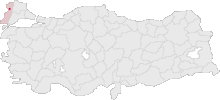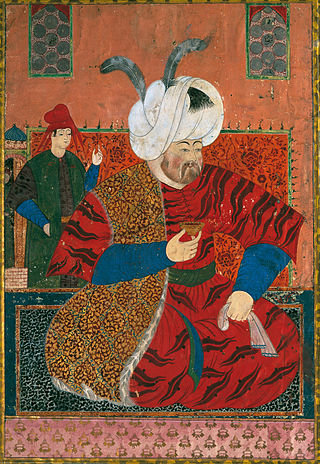
Selim II, also known as Selim the Blond or Selim the Drunkard, was the sultan of the Ottoman Empire from 1566 until his death in 1574. He was a son of Suleiman the Magnificent and his wife Hurrem Sultan. Selim had been an unlikely candidate for the throne until his brother Mehmed died of smallpox, his half-brother Mustafa was strangled to death by the order of his father and his brother Bayezid was killed on the order of his father after a rebellion against him and Selim.

Selim III was the sultan of the Ottoman Empire from 1789 to 1807. Regarded as an enlightened ruler, he was eventually deposed and imprisoned by the Janissaries, who placed his cousin Mustafa on the throne as Mustafa IV. A group of assassins subsequently killed Selim.

Mustafa IV was the sultan of the Ottoman Empire from 1807 to 1808.
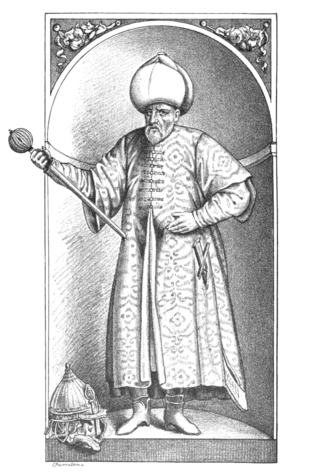
Sokollu Mehmed Pasha was an Ottoman statesman of Serb origin most notable for being the Grand Vizier of the Ottoman Empire. Born in Ottoman Herzegovina into an Orthodox Christian family, Mehmed was recruited as a young boy as part of so called "blood tax" to serve as a janissary to the Ottoman devşirme system of recruiting Christian boys to be raised as officers or administrators for the state. He rose through the ranks of the Ottoman imperial system, eventually holding positions as commander of the imperial guard (1543–1546), High Admiral of the Fleet (1546–1551), Governor-General of Rumelia (1551–1555), Third Vizier (1555–1561), Second Vizier (1561–1565), and as Grand Vizier under three sultans: Suleiman the Magnificent, Selim II, and Murad III. He was assassinated in 1579, ending his near 15-years of service to several Sultans, as sole legal representative in the administration of state affairs.

Alemdar Mustafa Pasha was an Ottoman military commander and grand vizier.

The Nizam-i Cedid was a series of reforms carried out by Ottoman Sultan Selim III during the late 18th and the early 19th centuries in a drive to catch up militarily and politically with the Western powers. The New Order regime was launched by Selim III and a coalition of reformers. Its central objectives were the creation of a professional army along European lines, a private treasury to finance military spending, and other administrative reforms. The age of the New Order can be generally said to have lasted from 1789 to 1807, when Selim III was deposed by a Janissary coup.

The history of the Ottoman Empire in the 18th century has classically been described as one of stagnation and reform. In analogy with 18th-century France, it is also known as the Ancien Régime or Old Regime, contrasting with the "New Regime" of the Nizam-i Cedid and Tanzimat in the 19th century.
The Bosnian uprising was a revolt of Bosnian ayans against the Ottoman Sultan Mahmud II. The casus belli were reforms implemented by the Sultan to abolish the ayan system.
Çandarlı Halil Pasha, known as the Younger, was a highly influential Ottoman grand vizier under the sultans Murad II and, for the first few years of his reign, Mehmed II. He was a member of the Çandarlı family, a highly influential political family in the Ottoman Empire. His grandfather and namesake, Çandarlı Kara Halil Hayreddin Pasha, also earlier served as grand vizier, under Murad I.

The Charter of Alliance also known as Deed of Agreement was a treaty between the grand vizier of the Ottoman Empire and a number of powerful local rulers signed in 1808, in an attempt to regulate their power and relations with the central Ottoman government.
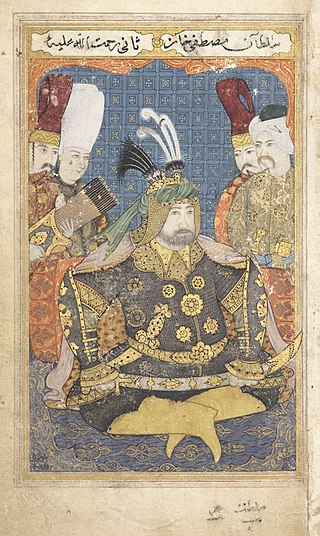
The Edirne Incident was a janissary revolt that began in Constantinople in 1703. The revolt was a reaction to the consequences of the Treaty of Karlowitz and Sultan Mustafa II's absence from the capital. The rising power of the Sultan’s former tutor, Şeyhülislam Feyzullah Efendi and the empire's declining economy caused by tax farming were also causes of the revolt. As a result of the Edirne Incident, Şeyhülislam Feyzullah Efendi was killed, and Sultan Mustafa II was ousted from power. The Sultan was replaced by his brother, Sultan Ahmed III. The incident contributed to the decline of the power of the sultanate and the increasing power of the janissaries and kadis.
Kabakçı Mustafa was a rebel leader who caused the delay of Ottoman reformation in the early 19th century.

Yunus Pasha was an Ottoman statesman. He was Grand Vizier of the Ottoman Empire for eight months in 1517, serving from January 30 until his death on September 13.

Piri Mehmed Pasha was an Ottoman statesman, and grand vizier of the Ottoman Empire from 1518 to 1523.
Serdar Ferhat Paşa was an Ottoman statesman of Albanian descent. He was twice grand vizier of the Ottoman Empire between 1 August 1591 and 4 April 1592 and between 16 February 1595 and 7 July 1595.
Mehmed Selim Pasha was an Ottoman statesman. He was Grand Vizier of the Ottoman Empire. He ruled from 14 September 1824 to 24 October 1828 as Grand Vizier of sultan Mahmud II and failed in the fight against the Greek War of Independence. The Auspicious Incident, the Battle of Navarino (1827), happened during his period in office. In 1828–30 he became Wali (governor) of Rumelia Province and 1830–31 Wali of Damascus (Syria). When the citizens of Damascus and the local garrison of Janissaries rose in revolt against him, Selim Pasha sought refuge into the Citadel of Damascus. After a siege lasting 40 days he was promised safe passage but murdered before he could leave the city.

The Mansure Army was an ocak of the Ottoman army. It was established by Mahmud II, who also disbanded the Janissary Corps.
Bekri Mustafa Pasha was an Ottoman grand vizier during the Great Turkish War.

The term Nizam-i Djedid Army refers to the new military establishment of the Nizam-i Cedid reform program which started in the Ottoman Empire c. 1789. The Nizam-i Djedid Army, largely a failure in its own time, nevertheless proved a much more effective infantry force than the Janissaries.
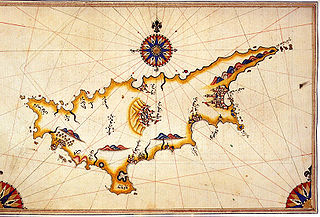
Osman Fazli, was a Jelveti Sufi spiritual guide in 17th-century Ottoman Empire. He spent c.25 years teaching and preaching, and became head Sheikh of the order in Istanbul and led the studies, conversation, meditation, and dhikr. But when he was about 48 it was revealed to him that the Ottoman Empire would fall into ruin, and, although he was of reclusive temperament, felt the only way to care for its population was to be at the Sultan's court. There he was outspoken against many of the Grand Vizier's plans: that they would bring disaster and misfortune, and he was proven right. He spent some years at court but when he declared one Grand Vizier's plan as against the sharia and distorting the Quran, the only way the Vizier could silence him was with exile. Osman Fazli went into retreat but emerged with a different course of action: he was leading a band of Sufis towards the battlefront when he was arrested and exiled for good. Osman Fazli exemplifies the Jelveti way: that following union with Allah he returns and acts in the world. He is hushyar (awake).
